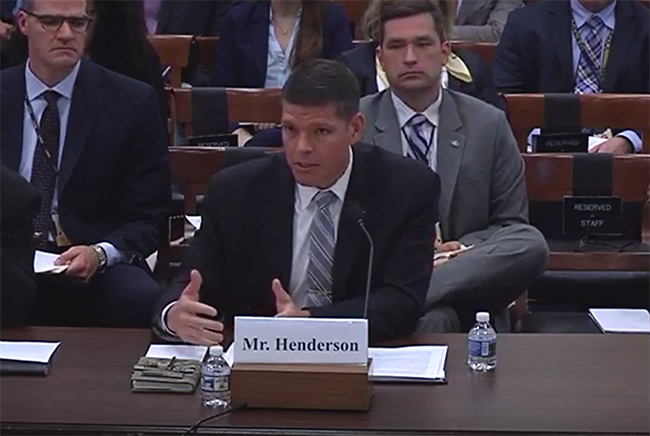
John Henderson, the Air Force's assistant secretary for installations, environment, and energy, testifies before the House Appropriations defense subcommittee on May 1, 2019. YouTube screenshot.
Transferring property from six military installations that were shut down in the last Base Realignment and Closure round from 2005 will take at least six years longer than expected because the Air Force needs to spend that money to address drinking water contamination, according to the service’s top installations official.
The process of shifting property back into local communities’ hands is now slated to wrap up by 2027, John Henderson, assistant secretary for installations, environment, and energy, said in prepared testimony submitted for a House Appropriations defense subcommittee hearing Wednesday. His testimony did not name the installations that will have to wait.
“Our BRAC cleanup program focuses on protecting human health and the environment, as well as projects that transfer acreage and achieve beneficial reuse of property,” Henderson wrote. “The Air Force transferred more than 98 percent of the property from 40 formerly closed installations back to communities for beneficial use, producing $2.9 billion in annual savings.”
Looking forward, the Air Force says it needs $54 million to cover BRAC-related work in fiscal 2020. The remaining 2 percent of property transfer projects are spread across six bases. Of the 40 bases affected by BRAC, 35 of those still need some combination of property transfer and environmental restoration work.
But now the BRAC program has to shift additional dollars to deal with water contaminants like perfluorooctane sulfonate and perfluorooctanoic acid, known as PFAS and PFOA.
Many of the Air Force’s 13,200 environmental restoration projects at current and former installations focus on “emerging contaminants,” to include PFAS and PFOA, according to the testimony. The substances, shown to cause adverse health effects including cancer, are found in firefighting foam previously used by the Air Force that has since seeped into groundwater around the country.
“From fiscal years 2013 to 2018, the BRAC program originally budgeted $64.9 million for [PFAS- and PFOA-]related requirements,” Henderson said. “However, due to additional requirements to protect public health and drinking water, we have to date spent $129.9 million in BRAC funds for PFOS and PFOA identification, investigation, and remediation.”
Of that total, the service pulled $65 million from other environmental projects.
Henderson also told lawmakers the service has spent about $300 million to remediate PFAS and PFOA over the last few years and wants $303 million in fiscal 2020 alone to continue the effort, which he said will take a whole-of-government approach.
“If authorized and funded by Congress to study BRAC, we would use the authority to develop realignment options to better support the National Defense Strategy,” Henderson’s testimony added.